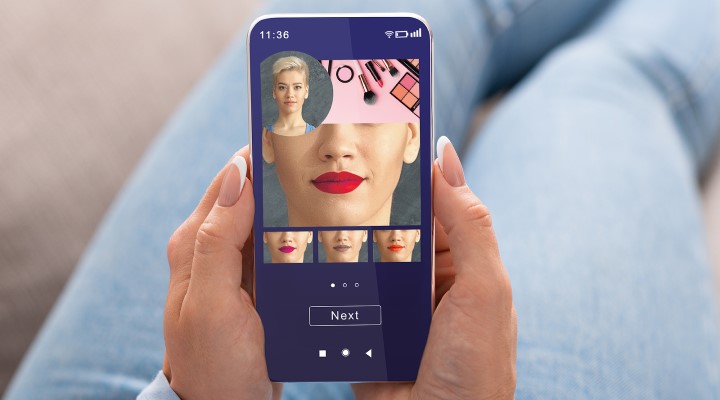Snap Inc is positioning itself as a platform for AR shopping with the recent acquisition of Vertebrae, a tech business that creates 3D models of products for customers to interact with.
According to an International Data Corporation (IDC) study, AR is anticipated to see compound annual growth rates of up to 135 per cent in retail market spend by 2023, and Snap is eager to get a slice of the pie.
Beatrice Romana, a teaching associate and PhD candidate studying the impact of augmented reality on customer experience in retail at Swinburne University of Technology, said the acquisition enhances the importance of AR as a powerful tool for shopping.
“Snap used to use AR purely for entertainment such as adding fun effects and filters when taking a selfie. However, they’ve realised that AR has a strong potential in retail,” Romano told Inside Retail.
“This acquisition symbolises a significant investment in the industry. While some brands have already started using AR, it is likely to become widespread.”
Snap’s recent collaboration with Gucci to launch the first global augmented reality shoe try-on campaign on the platform is evidence of its growing interest in this space.
Customers were invited to ‘try on’ four different pairs of the brand’s limited-edition sneakers. Once they had tried the sneakers, Snapchatters could then go straight to the product page and make a purchase via the “shop now” button.
“Not only did the AR try-on experience catch many Snapchatter’s attention, it also kept them engaged. And this engagement translated into sales,” according to Snap.
“The shopping AR experience generated positive ROAS, as Snapchatters were purchasing the products from the app. Not bad for a campaign that was only supposed to generate awareness and engagement.”
Gucci also unveiled its AR glasses, Spectacles 4, on the platform recently.
Not just luxury
But it’s not just luxury brands that are taking advantage of the rise in AR. Swedish furniture retailer Ikea is continually advancing its AR capabilities via Ikea Place, an app that allows customers to try out different furniture in their homes.
The latest update, known as Studio Mode, interprets users’ existing homes to offer furnishings that complement the space and style. It also uses detailed 3D information to digitally furnish traditionally hard-to-reach places for AR such as walls, ceilings and table tops.
“AR experiences thus far have been limited by the fact that they can understand and react to the environment within which they’re taking place. Studio Mode with the new iPad Pro presents powerful proof of the potential AR and AI have to deliver more meaningful, personal, and playful experiences at home with IKEA,” said Kaave Pour, director at Ikea’s research and design lab SPACE10.
Romano says Ikea has used AR to its advantage by understanding the uncertainty customers face when selecting the most appropriate furniture for their space.
“When shopping online, if consumers are unsure about a product, they often purchase it with the option to return it should it be unsuitable. However, with furniture it is not as easy as placing the sachet in the post box; it is difficult to visualise an item of furniture in our own space,” she said.
Virtual try-ons advance hair and beauty
AR has become increasingly popular in hair and beauty, with consumers eager to test out new hair colours and makeup looks both via social media and on brand websites.
Rimmel, Maybelline, Garnier and Redken are all currently offering AR try-on services online.
However, this type of experience could soon become more common in bricks-and-mortar settings. Amazon’s recently-opened hair salon in London offers AR consultations that allow customers to try on virtual hair colours.
In Australia, digital hair care business Piiq, run by award-winning Redken global artist Richard Kavanagh, is introducing technology to salons to help “Amazon proof” their business.
Its AR service Piiq Paint uses 138-point facial analysis to provide a measurement of bone structure and matches them with a selection of celebrities that share similar features.
“Each celebrity is shown with 12 different curated styles and colours to inspire them with looks that will suit and show them what won’t suit and why,” Kavanagh explained.
He said the service allows the hairdresser complete control over depth, intensity and transparency of colour so they can give an accurate representation of a warm vs cool colour, or between a toner, semi or a permanent colour.
The client can then share the look to their social media, automatically tagging the salon in the process.
Pandemic prompts rise in AR
Romano says AR works well in retail categories that have a strong visual component.
“Consumers like to see what an item would look like offline. In e-commerce, a lot of item returns happen as the product looks different from the image in the e-store. This is why for AR, fashion would be a strong category, but groceries maybe not as much,” she said.
As with most emerging technology, consumers will adopt it at a different pace, according to Romano, but she believes the boom in online shopping driven by the pandemic may have an impact.
“[The pandemic] has highlighted downsides of both traditional bricks-and-mortar, and e-commerce. This might have also accelerated the need for AR,” she said.
“AR can in fact tap into and overcome shortcomings. For consumers, AR provides greater convenience, accessibility, and increased interaction. It allows them to make purchases at a time and place of their convenience, such as from the comfort of their home. And being able to better visualise the product, [they are likely to] feel assured of their decision, which is in contrast to traditional e-commerce.”
Romano believes this increase in confidence could result in a decrease in number of product returns too.
AR isn’t always the answer
Although Romano believes AR is an excellent tool for shopping, she says it’s important to remember that it doesn’t always benefit consumers.
“[AR] can both help and hinder the customer experience. If retailers wish to implement it, they should consider who the customers are, and what the aim of this tool would bring to the brand,” she said.
“It is also key to understand the customer segments that would purchase that brand. Not everyone is willing to use AR, and retailers need to understand that.”
The most important factor in introducing an AR experience, Romano says, is ensuring that it is seamless.
“Consumers don’t like glitches and long loading times. They need to be engaged, so the experience should be smooth and straightforward.”
Privacy concerns are also a prominent factor: “Consumers may be hesitant to upload a picture on a website, instead they’d prefer pointing their camera at it.”






